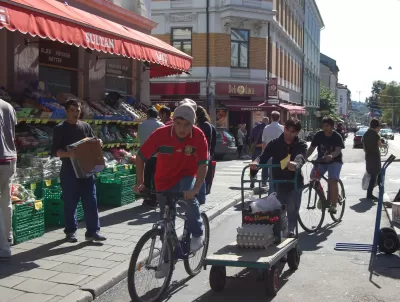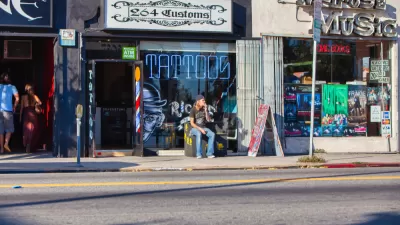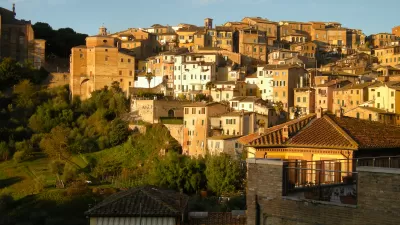Research across a range of fields is beginning to offer useful new guidance for planning policy and practice—and pointing the way to more effective "bottom-up" strategies.

The urbanist Jane Jacobs was famous for her withering 1961 criticism of modern urban planning: it was, she said, a "pseudoscience" that was "almost neurotic in its obsession to imitate empiric failure and ignore empiric success." Since then, by some accounts, planners and urban designers have not fared much better. In 2012, a Scientific American article highlighted the similarly damning work of Stephen Marshall of University College London. Writing in the journal Urban Design International, Marshall presented evidence that in spite of lip service to work by Jacobs and others, urban planning remains burdened by a pseudo-scientific approach. The press coverage provoked considerable debate and soul-searching on discussion lists and blogs.
Is the criticism fair? One way to evaluate the scientific rigor of planning is to assess its topics from the perspective of other, more recognized "natural" sciences. For physicists, for example, a city is an immensely complex physical system with many layers of social and technological interaction. Physicists like Luis Bettencourt and Geoffrey West are describing the workings of urban systems with new mathematical precision—and doing, as West puts it, "Jacobs with the math." (Others active in this field include the urban morphologists Mike Batty and Sergio Porta, the mathematician Nikos Salingaros, and the urban economist Jose Lobo.)
Why do we need such a science? Over the next five decades, if present trends do not reverse dramatically, humanity is set to create more sheer volume of urban settlement than it has in all of human history. What are the implications for the Earth's ecology, for the viability of future economies, and for the quality of human life? We desperately need tools to help to answer these questions—tools that constitute a science by any other name.
As with any good science, the proper aim of a science of cities should be to deepen our understanding of what's really going on, in a way that we humans will find useful. Cities are, in spite of their complexity, comprehensible systems, no less than human bodies are: as Jacobs argued, useful observations can be made about their features, much as diagnoses can be made by doctors about the human body, applying the insights provided by medical science. In a similar way, we can use the insights of a science of cities to judge the outcomes and needed changes in current best practices.
Indeed, it was Jacobs herself who first saw this connection to the biological sciences, writing presciently about the subject in the last chapter of her landmark book The Death and Life of Great American Cities. In part she drew inspiration from her mentor Warren Weaver, a mathematician and one of the pioneers of what is now described as the "sciences of complexity." But Jacobs was also a keen observer and interpreter of what she saw, with the aim of developing a reliably useful understanding of how things actually worked in cities.
How have Jacobs's insights held up? Stephen Marshall makes the case that she opened a door to a more rigorous scientific approach—but too few entered it. In fact many subsequent theorists simply took Jacobs's ideas as yet another set of poorly applied pseudo-scientific doctrines.
But recent work is, indeed, further illuminating many of the same issues that concerned Jacobs, and moreover, it is applying new mathematical and analytical tools that were unavailable to her. On the basis of these developments, it does not seem too much to say that a recognizable new “science of cities” (new at least by historic standards) is emerging across the full spectrum of urban disciplines, from physics and biology to social psychology and sociology.
This new science is built on several key insights:
Cities are spatial networks. We can see that cities are dense networks of interconnected pathways that are regulated by a series of gateways, which vary in the degree to which they permit or restrict movement (think of a traffic light on a street or the lock on one's front door). Importantly, the geometric pattern of connectivity plays a central role in what can happen within the network. For example, a "tree-like" street system requires, on average, a much greater investment of time, energy, financial cost, and other resources to move around than does a more densely interconnected web-network.

Cities are social networks. Cities also connect people, or alternately restrict their connections, which further facilitates or restricts their social and economic interaction, exchange, creativity, and enterprise. Equally cities facilitate or restrict conflict, exploitation, and harm. This network thus provides the capacity to control the level of interaction to maximize beneficial interaction and to minimize harmful interaction.
Cities are partially decentralized and partially generated by self-organizing agents. Moreover, the individuals themselves can partially increase or decrease that contact through their autonomous regulation of mediations between the public realm and layers of more private spaces, connected into a spatial network. In ordinary terms, we can lock our front doors, draw our window blinds, and retreat into our bedrooms—or alternately, go out to our front entrance yard, meet neighbors, enter the streets and squares, and enter public or semi-public buildings. Over longer spans of time, we can actually modify this structure—put up new blinds, build a new doorway or fence, or even build a building or addition.


Cities are partially "scale-free." The structures and processes that occur tend to be self-similar across scales, or "fractal," in the same way that the trunks, branches, and twigs of a tree are self-similar. This has important implications for the way a city functions.
Cities are also partially "scale-dependent." The agents of a city are primarily active within a particular scale: the scale of the human animal and its pedestrian-scale activities. There are also important limits at other scales—for example, the scale of vehicular movement and the interfaces between modes of movement.
Cities are cognitive and symbolic systems. The agents of a city are human beings who must navigate, make sense, and find meaning within the structure of the city, through all the scales of their experience.
These six attributes turn out to have important—and until now under-appreciated—implications for the most effective strategies of planning and urban design.
Most evidently, a city can be seen as a particular kind of "socio-economic reactor," able to promote the efficient exchange and creative interaction between people—but only to the extent that its network structure provides that capacity. Research is demonstrating that public spaces created by infrastructure networks—the walkable streets, sidewalks, parks and other spaces—play a fundamental role in social and economic interaction rates. This is confirmation of an early insight by Jacobs, that seemingly random and purposeless sidewalk contacts are the "small change" from which a city's wealth accumulates.
Why are walkable public spaces so important? It seems they support casual encounters within a much wider network of acquaintances. These interactions facilitate the production of knowledge exchanges, or what economists refer to as economic "spillovers" (sometimes referred to as "Jacobs spillovers" in honor of Jacobs's work in this area). In turn this interaction seems to be key to the creativity and productivity of cities. We have seen the results in great cities like New York, which routinely perform the remarkable feat of taking in many thousands of penniless immigrants, and somehow producing solidly middle class business owners or professionals.
But what of more suburban cities with much less connected public realms, such as those of the American Sunbelt: do they not also have strong innovation economies? We can indeed see a similar pattern of social interaction in the Sunbelt. But importantly, the infrastructure that supports this interaction is not an urban network of public spaces, but a private infrastructure that is much more dependent upon automobiles, telephones, and the Internet—and the unsustainably high consumption of resources required to maintain their operation. For that reason, this system is certainly more sensitive to resource shocks (such as rapid fluctuations in energy prices) and, in that light, it appears much less resilient than a system of urban place networks. It may have other important functional limitations as well.
There may also be important limitations on electronic forms of social networks in comparison to other more physical connections, as the sociologist Robert Putnam and others have shown. There may even be important cognitive and behavioral effects from the newer and more artificial network structures that lead to differences in resource consumption—a subject of active research at present. These and other insights suggest that such networks should work to complement, and not to replace, the remarkable benefits of urban place networks.
All these findings may also help to explain the resource efficiency of cities. It has long been observed that cities show dramatically lower per capita rates of resource use and greenhouse gas emissions—even when taking into account their greater average affluence. Part of that efficiency undoubtedly comes from the greater density of cities, and part comes from reduced auto use – but an intriguingly large part of it seems to come from the web-network pattern of urban connections itself. Put simply, the redundancies in the pattern create the possibility of feedback loops, setting the stage for a kind of “metabolic” recycling of resources, and resulting in dramatically higher resource efficiency. This suggests an important urban dynamic that can be exploited, not only in large cities, but in settlements of any size.

Another key finding of this work is that the socio-economic potential of a city is maximized when all of its citizens are socially connected and included. By contrast, to the degree that cities exclude some populations, or limit their transportation mobility and safety, then the entire city under-performs socially and economically to that extent. When it comes to cities, it seems clear that social inclusion is good for the bottom line. As Luis Bettencourt notes, this means that effective urban planning should promote pervasive social connectivity, by planning spatial land use and infrastructures (e.g., street networks) that are commensurate with these properties over the city as a whole.
Many of the new settlements around the world are "informal" squatter settlements and slums. The emerging "science of cities" tells us important and useful things about the challenges ahead for these and other rapidly urbanizing places. In fact, these settlements, for all their problems, actually demonstrate remarkable inherent capacities of self-organization, growth, and efficiency. The challenge is not to get rid of them but to strengthen their capacities and their inherent tendencies toward healthy self-organization. They have a lot of lessons to offer about what Jacobs termed "the kind of problem a city is."
As Jacobs pointed out, a city is a system with an immense number of heterogeneous agents—the people who live, interact, and create there. Each of these agents is best positioned to make choices on the basis of specific local information, adequate to their own goals and aspirations—as long as these choices do not limit similar choices made by others. This is, of course, what legal and market systems manage to do at their best and what planning, conceived as a top-down enterprise, finds extremely challenging—even logically impossible as seen in the light of today's complexity science.
But this is hardly a simplistic prescription for laissez-faire policies or an end to planning as such. On the contrary, it's a call for a shift to a different and more effective kind of planning. It's a plea to seek greater understanding of the dynamics by which a city spontaneously self-organizes and the ways those dynamics can be guided and catalyzed by planners toward much more benign outcomes. It points the way to effective application of tools for a more "generative" planning approach, working in networks across many scales of democratic and participatory action.
Like doctors who understand and support the body's own immune system function, we can begin to understand and support the vernacular processes that are already occurring—and have occurred for centuries, making some of the world's most complex, efficient, high-functioning urbanism today. By contrast, it is our supposedly "modern" methods of top-down, functional segregation that now look antiquated, primitive, and grossly inadequate for the challenges ahead.
In that light, such a union of the art of planning and the science of cities may be the best way to dispel the charge of "pseudo-science"—and, moreover, to achieve a new quality of human outcome, in an era when it is so desperately needed.
Michael Mehaffy is a planner, urban designer, and executive director of the Portland, Oregon-based Sustasis Foundation, where he works with colleagues on new neighborhood-scale and "peer to peer" planning tools. He is indebted to Luis Bettencourt for some of the significant concepts discussed in this essay.

Planetizen Federal Action Tracker
A weekly monitor of how Trump’s orders and actions are impacting planners and planning in America.

Restaurant Patios Were a Pandemic Win — Why Were They so Hard to Keep?
Social distancing requirements and changes in travel patterns prompted cities to pilot new uses for street and sidewalk space. Then it got complicated.

Maui's Vacation Rental Debate Turns Ugly
Verbal attacks, misinformation campaigns and fistfights plague a high-stakes debate to convert thousands of vacation rentals into long-term housing.

In California Battle of Housing vs. Environment, Housing Just Won
A new state law significantly limits the power of CEQA, an environmental review law that served as a powerful tool for blocking new development.

Boulder Eliminates Parking Minimums Citywide
Officials estimate the cost of building a single underground parking space at up to $100,000.

Orange County, Florida Adopts Largest US “Sprawl Repair” Code
The ‘Orange Code’ seeks to rectify decades of sprawl-inducing, car-oriented development.
Urban Design for Planners 1: Software Tools
This six-course series explores essential urban design concepts using open source software and equips planners with the tools they need to participate fully in the urban design process.
Planning for Universal Design
Learn the tools for implementing Universal Design in planning regulations.
Heyer Gruel & Associates PA
JM Goldson LLC
Custer County Colorado
City of Camden Redevelopment Agency
City of Astoria
Transportation Research & Education Center (TREC) at Portland State University
Camden Redevelopment Agency
City of Claremont
Municipality of Princeton (NJ)




























